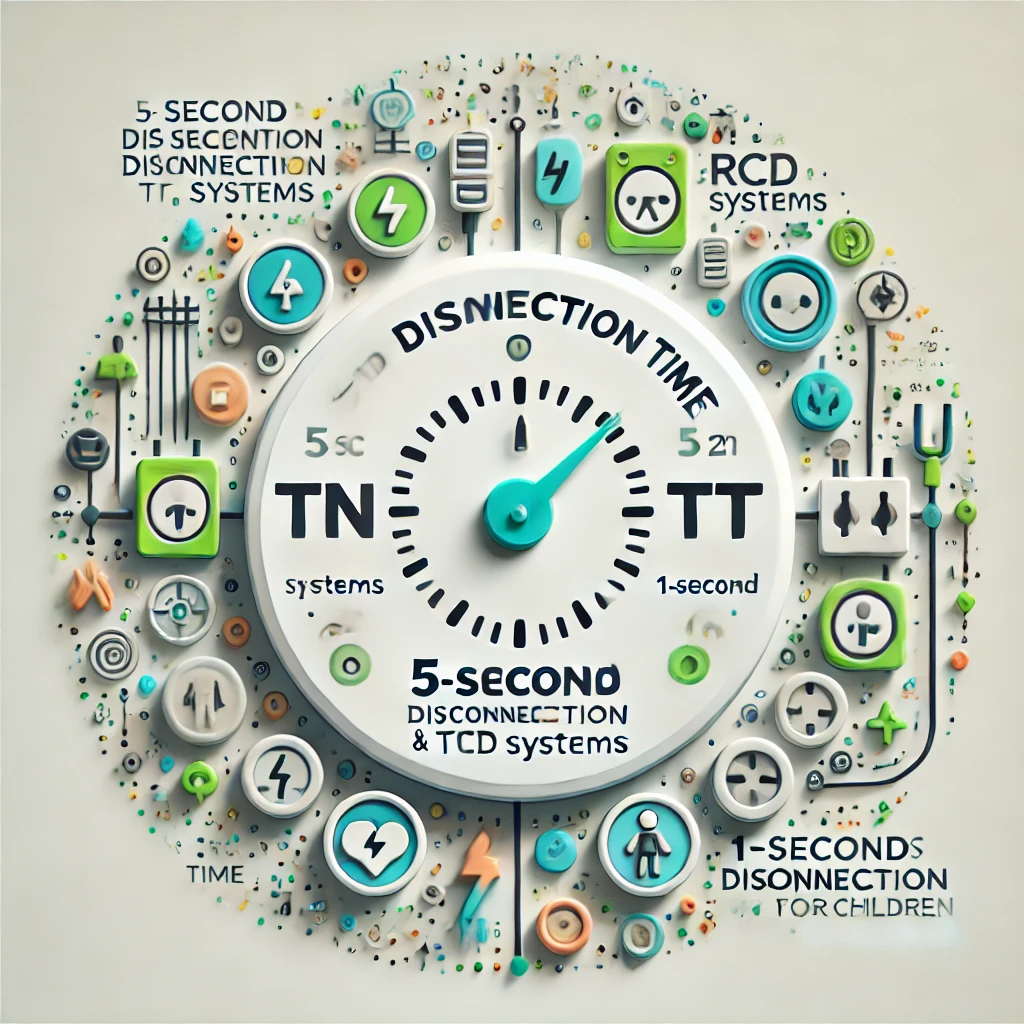What Are the Requirements for Disconnection Times in TN and TT Systems and RCD Protection in Distribution Circuits and Socket-Outlets?
Regulation 411.3 of BS 7671 specifies the disconnection times for TN and TT systems and the need for RCD protection in distribution circuits and socket-outlets, particularly in areas accessible to the public and for mobile equipment used outdoors. Understanding these requirements is crucial for electrical safety.

OW London Electrician and Home Automation Engineers Team
What Are the Requirements for Disconnection Times in TN and TT Systems and RCD Protection in Distribution Circuits and Socket-Outlets?
When dealing with electrical installations, particularly in distribution circuits and socket-outlets, understanding the requirements for disconnection times and the use of Residual Current Devices (RCDs) is crucial for ensuring safety. The regulations provide specific guidelines for both TN (Terra Neutral) and TT (Terra Terra) systems, emphasizing the importance of timely disconnection of circuits to prevent electric shock. Additionally, the regulations highlight when and where RCD protection must be implemented, especially in socket-outlets and mobile equipment.
Regulation 411.3.2.3 – Disconnection Time in TN Systems
Regulation 411.3.2.3 states:
"In a TN system, a disconnection time not exceeding 5 s is permitted for a distribution circuit and for a circuit not covered by Regulation 411.3.2.2."
Regulation 411.3.2.4 – Disconnection Time in TT Systems
Regulation 411.3.2.4 states:
"In a TT system, a disconnection time not exceeding 1 s is permitted for a distribution circuit and for a circuit not covered by Regulation 411.3.2.2."
Regulation 411.3.2.5 – Exceptions to Disconnection Times
Regulation 411.3.2.5 states:
"Where it is not feasible for an overcurrent protective device to interrupt the supply in accordance with Regulation 411.3.2 or the use of an RCD for this purpose is not appropriate, see Section 419. However, disconnection may be required for reasons other than protection against electric shock."
Regulation 411.3.3 – Additional Requirements for Socket-Outlets and for the Supply of Mobile Equipment for Use Outdoors
Regulation 411.3.3 states:
"In AC systems, additional protection by means of an RCD with a rated residual operating current not exceeding 30 mA shall be provided for:
- (i) Socket-outlets with a rated current not exceeding 32 A in locations where they are liable to be used by persons of capability BA1, BA2, or BA3,
- (ii) Socket-outlets with a rated current not exceeding 32 A in other locations, and
- (iii) Mobile equipment with a rated current not exceeding 32 A for use outdoors.
An exception to (ii) but not (i) or (iii) is permitted where a suitably documented risk assessment undertaken with the involvement of a skilled person (electrically) determines that RCD protection is not necessary."
NOTES:
- For the purpose of this exception, an ordinary person (BA1) instructed in the use of the installation does not become an instructed person (electrically) or cease to be an ordinary person.
- The requirements of Regulation 411.3.3 do not apply to FELV systems according to Regulation 411.7 or reduced low voltage systems according to Regulation 411.8.
- RCD protection of all socket-outlets is recommended.
- See Appendix 2, item 11 in respect of risk assessment.
- A lighting distribution unit complying with BS 5733, shaver supply unit complying with BS EN 61558-2-5, luminaire track system, installation coupler, LSC or DCL is not regarded as a socket-outlet for the purposes of this regulation.
Simplified Explanation:
These regulations cover the safety requirements for disconnection times in TN and TT systems and the necessity of RCD protection in various settings, particularly for distribution circuits, socket-outlets, and mobile equipment.
Regulation 411.3.2.3 (Disconnection Time in TN Systems):
- Disconnection Time: In a TN system (where the neutral and earth are connected at the supply source, providing a reliable path for fault currents), the maximum allowable disconnection time for a distribution circuit is 5 seconds. This extended time is permissible due to the lower risk associated with the more reliable earthing in TN systems. It also applies to circuits not covered by Regulation 411.3.2.2, which deals with final circuits.
Regulation 411.3.2.4 (Disconnection Time in TT Systems):
- Disconnection Time: In a TT system (where the earth is provided locally at the installation site, often less reliable than TN systems), the maximum allowable disconnection time for a distribution circuit is 1 second. This shorter time is necessary to mitigate the higher risk of electric shock in TT systems due to their dependence on local earthing conditions.
Regulation 411.3.2.5 (Exceptions to Disconnection Times):
- Exceptions: If an overcurrent protective device or an RCD cannot feasibly meet the required disconnection times, alternative measures must be considered as per Section 419. However, disconnection might still be necessary for reasons beyond just preventing electric shock, such as fire protection.
Regulation 411.3.3 (RCD Protection for Socket-Outlets and Mobile Equipment):
- RCD Requirement: In AC systems, RCD protection with a residual operating current of 30 mA or less is mandatory for:
- Socket-outlets up to 32 A in locations accessible to ordinary persons (BA1) or children (BA2, BA3).
- All other socket-outlets up to 32 A, unless a risk assessment by a skilled person deems it unnecessary.
- Mobile equipment up to 32 A used outdoors.
- Exceptions: RCD protection can be excluded for some socket-outlets (not used by children or outdoors) if a thorough risk assessment by a skilled person determines that RCD protection is unnecessary. However, this exception does not apply to socket-outlets in locations accessible to children or to mobile equipment used outdoors.
Frequently Asked Questions
Q: What is the difference between TN and TT systems in terms of disconnection times?
A: In a TN system, the maximum allowable disconnection time for a distribution circuit is 5 seconds due to the reliable earthing provided by the connection between neutral and earth at the supply source. In contrast, a TT system has a shorter allowable disconnection time of 1 second due to the higher risk associated with its reliance on local earthing, as specified in Regulation 411.3.2.3 and 411.3.2.4.
Q: Why is RCD protection required for socket-outlets in different locations?
A: RCD protection is crucial because it detects earth faults and disconnects the supply quickly to prevent electric shock. This is especially important for socket-outlets accessible to ordinary persons (BA1) and children (BA2, BA3), as well as for mobile equipment used outdoors, where the risk of electric shock is higher, according to Regulation 411.3.3.
Q: Are there any circumstances where RCD protection is not required for socket-outlets in a TN or TT system?
A: Yes, an exception can be made for socket-outlets not accessible to children or not used outdoors if a detailed risk assessment by a skilled person (electrically) determines that RCD protection is unnecessary. However, RCD protection remains mandatory for socket-outlets in locations accessible to children and for mobile equipment used outdoors, as per Regulation 411.3.3.
Q: What does BA1, BA2, BA3 mean in relation to RCD protection?
A: These are categories of persons defined in the regulations:
- BA1: Ordinary persons with no specific electrical knowledge.
- BA2: Children.
- BA3: Persons with limited electrical knowledge. RCD protection is particularly important for socket-outlets accessible to these groups, as detailed in Regulation 411.3.3.
Q: What happens if an overcurrent protective device cannot meet the disconnection times in a TN or TT system?
A: If an overcurrent protective device or an RCD cannot feasibly achieve the required disconnection times, other safety measures as outlined in Section 419 must be considered. However, it’s essential to ensure that disconnection occurs for other safety reasons, such as preventing fire hazards, as specified in Regulation 411.3.2.5.

What users Saying
Discover what our customers think about our services. Their feedback reflects our commitment to delivering exceptional service and expert solutions for all electrical and security needs.

